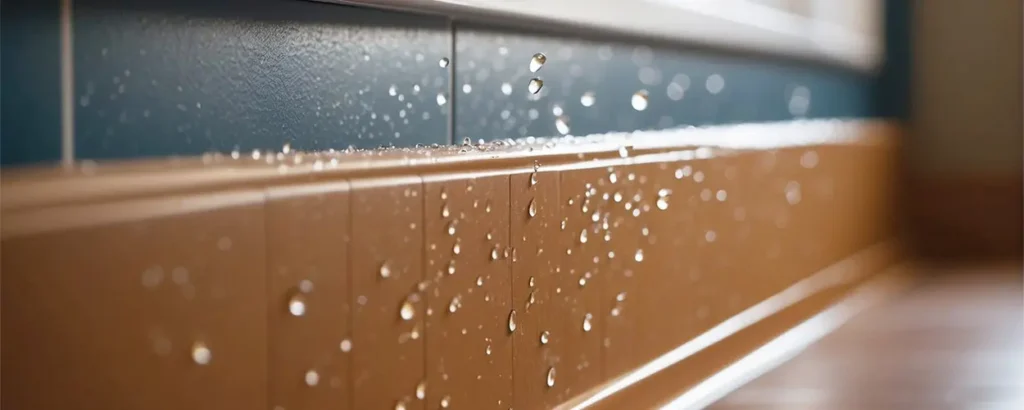Medium-Density Fiberboard (MDF) is a staple in furniture and cabinetry for its smooth surface and affordability. However, its one major weakness is its vulnerability to moisture. Standard MDF acts like a sponge, swelling and crumbling upon contact with water, making it unsuitable for many areas of the home.
This is where Moisture-Resistant MDF (often called MR MDF or “green MDF” due to its distinctive green-tinted core) comes to the rescue. But what exactly is it, and is it the right choice for your bathroom or kitchen project? This guide will break down when and where to use this specialized material and when to choose a more robust alternative.

1. What is Moisture-Resistant MDF? (It’s Not Waterproof)
First, it’s crucial to understand what MR MDF is—and what it is not.
- The Technology: MR MDF is manufactured with specialized resins and wax additives that are blended with the wood fibers during production. These additives significantly reduce the board’s ability to absorb moisture from the air and resist swelling better than its standard counterpart.
- The Key Distinction: Moisture-Resistant is not Waterproof. MR MDF is designed to handle humid environments and occasional minor splashes. It is not designed to be soaked, submerged, or have standing water left on its surface. Think high humidity, not direct and constant water exposure.
2. The Best Uses for Moisture-Resistant MDF
Thanks to its improved resilience, MR MDF is perfect for a range of applications where standard MDF would fail.
- Bathroom Vanities and Cabinets: This is the prime use case. MR MDF can handle the steam from showers and occasional sink splashes without deteriorating, making it an excellent choice for vanity carcasses (the main box structure).
- Kitchen Cabinetry: Especially useful for cabinets near the sink or dishwasher where humidity and minor spills are common. It’s a great material for painted cabinet doors and panels.
- High-Humidity Climates: If you live in a region with consistently high humidity, MR MDF is a smarter choice for any interior furniture than standard MDF, which can swell from ambient moisture alone.
- Interior Trim and Millwork: Use it for baseboards, crown molding, and wainscoting in bathrooms, kitchens, laundry rooms, and basements where moisture levels fluctuate.
- Commercial Interior Projects: Ideal for retail displays, office furniture, and other commercial interiors that require a durable, paintable surface that can handle being cleaned.
3. Understanding Its Limitations: Where NOT to Use It
Knowing the limits of MR MDF will save you from a costly repair job down the line. Avoid using it in these situations:
- Direct Water Exposure: Do not use it for shower or tub surrounds, saunas, or outdoor furniture. It will not survive direct and constant water contact.
- Horizontal Surfaces Prone to Spills: While okay for kitchen cabinets, it is not suitable for countertops or bar tops where drinks, water, and other liquids will regularly pool and sit.
- Subflooring or Structural Applications: MR MDF has no structural strength and should never be used for subfloors, wall sheathing, or any load-bearing application.
- Areas with Poor Ventilation: Even MR MDF can eventually succumb to chronic, extreme dampness. If a room like a basement or bathroom has no ventilation, a plastic-based material or plywood is a safer bet.
4. Pro Tips for Working with MR MDF
To get the most out of your moisture-resistant MDF, follow these best practices:
- Seal All Edges and Cut Lines: The core of MR MDF is more resistant than standard MDF, but it is still vulnerable at any cut edge. Always seal exposed edges with a high-quality primer, paint, or edge banding.
- Use the Right Fasteners: Because it’s dense, pre-drill holes for screws to prevent splitting. Use specialized screws designed for MDF for the best holding power.
- Protect the Surface During Installation: While durable, the laminate surface can be scratched. Handle with care during the build process.
- Ensure Proper Ventilation: Even after installation, help your project last longer by ensuring the room has adequate ventilation (e.g., using a bathroom fan) to remove excess humidity.
Final Verdict: Is Moisture-Resistant MDF Right for You?
Yes, if… your project is for an interior space with high humidity or the risk of occasional splashes, and you need a smooth, affordable, and paintable material. Bathroom vanities, kitchen cabinets, and interior trim in damp areas are its sweet spot.
No, if… the material will be exposed to direct, standing water or weather. For those applications, you need to look to marine-grade plywood, PVC, or other solid plastics.

